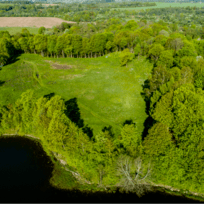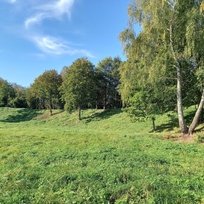The Eketė Hillfort, the largest hillfort in the Klaipėda district, is situated on the steep right bank of the Eketė Stream near its confluence with the Danė and Akmena rivers. Now, the Eketė Stream is dammed, and the hillfort stands on the northwest bank of the resulting pond, at the dam, where it is best accessible from the Klaipėda-Palanga highway by driving or walking for 3.5 kilometres along the roadway on the left bank of the Danė River.
The hillfort consists of the irregular square 110-metre-long and 105-metre-wide site and the 130-metre-long, 8-metre-high and 22-metre-wide semi-circular bank, surrounding it from the north side. At the outer foot of the bank, the remains of a second small bank can be seen, behind which, according to the data of the research conducted in 1972, three more banks were installed with ditches dug between them. The former wide (up to 20 metres) stretch of continuous fortifications prevented access to the 9-metre-high outer slope of the massive main bank from the upland side. From the side of the Eketė Stream, the site was protected by steep 10–20-metre-high slopes (currently only 8–9 metres above the water level in the pond) and a small bank filled on its edge.
The Eketė (Akutte) Curonian castle, which is mentioned in the document on the division of Curonia, stood on the hillfort in 1253. Judging by the size of the hillfort, it was rather a fortified town centre than a castle, especially so since the site of the old settlement located northeast of the hillfort occupies an area of at least 6 hectares.
Today, the Eketė hillfort is the most extensively researched in Klaipėda. In 1972, Algimantas Merkevičius (1933–2014) explored 240 square metres in the eastern part of the site and found a 0.3–1.4-metre-thick cultural layer, rich in finds and building remains. Among the more interesting finds, the iron tools (gouge, adze, hole punch and plane) of a craftsman, as well as an arrowhead, Roman coins, amber spindle, glass bead necklace, and clay weights for a loom, show that the excavations reached the place of the craftsman’s (carpenter’s) workshop. Those finds and the moulded smooth, rough and fired ceramics show that the hillfort was inhabited for more than a thousand years – from the beginning of the first millennium up to the middle of the 13th century.
A thick (up to 70 centimetres) cultural layer of this period is also found in the former settlement next to the hillfort, which was explored to some extent in the same year (1972) and later. The treasures hidden by the main bank, which surrounds the hillfort like a crown, are still a mystery.





Reviews